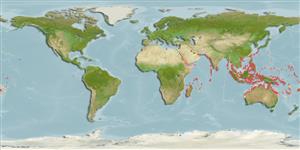Environment: milieu / climate zone / depth range / distribution range
Ecologie
marien; brak water rifbewoner; diepte 0 - 8 m (Ref. 9710). Tropical; 30°N - 23°S, 32°E - 169°W
Indo-Pacific: Red Sea and East Africa to Samoa, north to the Ryukyu Islands, south to the Great Barrier Reef and New Caledonia.
Grootte / Gewicht / Leeftijd
Maturity: Lm ? range ? - ? cm
Max length : 14.0 cm TL mannelijk / geslacht onbekend; (Ref. 48636)
Korte beschrijving
Determinatiesleutels | Morfologie | Morfometrie
Dorsale stekels (totaal) : 12; Dorsale zachte stralen (totaal) : 18 - 20; Anale stekels: 2; Anale zachte stralen: 19 - 21. Numerous pale spots, dark streaks anteriorly, and several dusky bands (Ref. 4404).
Facultative air-breathing (Ref. 126274); Adults inhabit reef flats as well as shallow lagoon and seaward reefs. Also found in estuarine areas with algae-rich rubble patches on reef flats and slopes. Intertidal to a few meters depth (Ref. 48636). Usually found in areas of mixed coral, sand, and rubble (Ref. 9710). Found solitary in weedy areas on rocks and coral outcrops (Ref. 90102). Feed by scraping off algae (Ref. 1602). Oviparous. Eggs are demersal and adhesive (Ref. 205), and are attached to the substrate via a filamentous, adhesive pad or pedestal (Ref. 94114). Larvae are planktonic, often found in shallow, coastal waters (Ref. 94114). Neither fang nor venom gland is present (Ref. 57406). Also Ref. 58652.
Levenscyclus en paargedrag
Maturities | Voortplanting | Spawnings | Egg(s) | Fecundities | Larven
Oviparous, distinct pairing (Ref. 205).
Randall, J.E., G.R. Allen and R.C. Steene, 1990. Fishes of the Great Barrier Reef and Coral Sea. University of Hawaii Press, Honolulu, Hawaii. 506 p. (Ref. 2334)
Status op de Rode Lijst van het IUCN (Ref. 130435)
Gevaar voor de mens
Harmless
Gebruik door de mens
Visserij: van minder commercieel belang; Aquarium: Commercieel
Tools
Speciale rapporten
Download XML
Internetbronnen
Estimates based on models
Preferred temperature (Ref.
123201): 25.4 - 29.3, mean 28.5 °C (based on 2623 cells).
Fylogenetische diversiteitsindex (Ref.
82804): PD
50 = 0.5001 [Uniqueness, from 0.5 = low to 2.0 = high].
Bayesian length-weight: a=0.00832 (0.00442 - 0.01565), b=3.02 (2.85 - 3.19), in cm total length, based on LWR estimates for this species & (Sub)family-body (Ref.
93245).
Trofisch niveau (Ref.
69278): 2.0 ±0.0 se; based on diet studies.
Weerstandsvermogen (Ref.
120179): Hoog, minimale populatieverdubbelingstijd minder dan 15 maanden (Preliminary K or Fecundity.).
Fishing Vulnerability (Ref.
59153): Low vulnerability (10 of 100).
Nutrients (Ref.
124155): Calcium = 129 [58, 221] mg/100g; Iron = 0.745 [0.415, 1.336] mg/100g; Protein = 18.2 [17.0, 19.3] %; Omega3 = 0.0797 [, ] g/100g; Selenium = 20.7 [9.3, 47.0] μg/100g; VitaminA = 96.6 [25.7, 368.8] μg/100g; Zinc = 2.78 [1.80, 4.27] mg/100g (wet weight);
